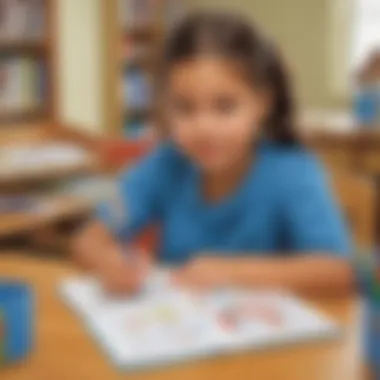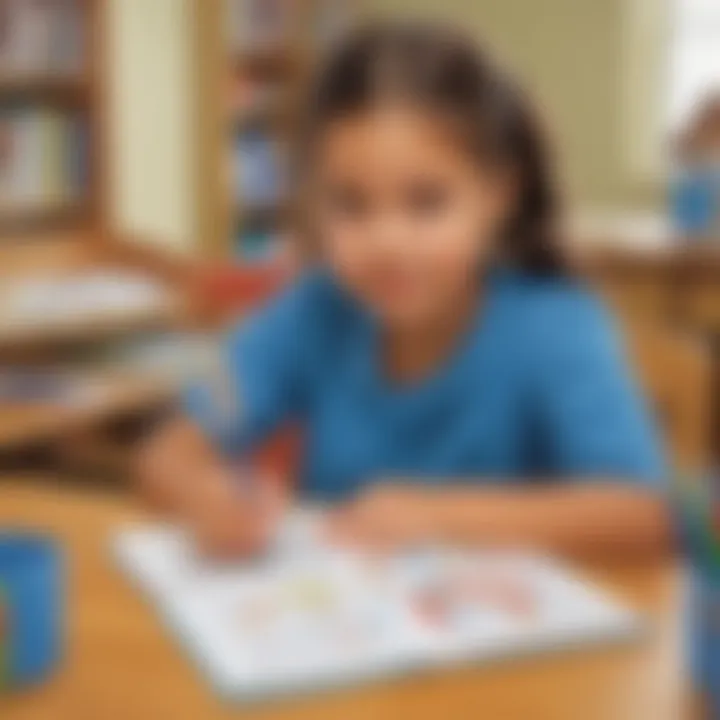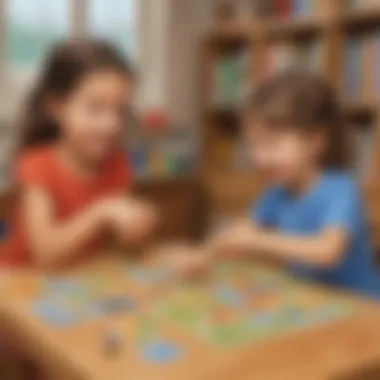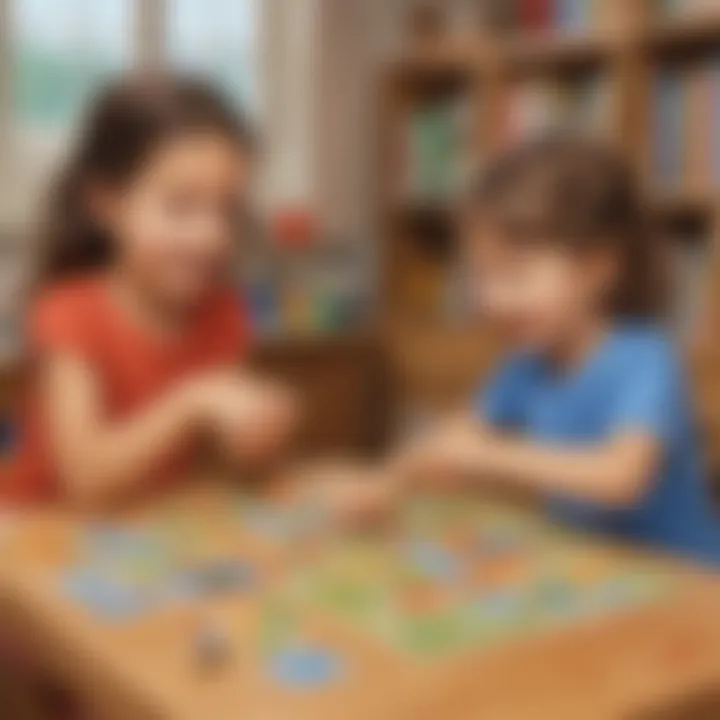Effective Techniques for Teaching Elementary School Kids Lowercase Letters


Creative Activities
Let's start by delving into some creative activities that can aid in teaching lowercase letters to elementary school children. Craft ideas play an essential role in making learning engaging and interactive for young minds. By incorporating simple yet fun craft activities such as creating letter-shaped art using colorful paper and markers, children can enjoy a hands-on approach to learning lowercase letters. These activities not only foster creativity but also help in solidifying letter recognition.
Step-by-Step Guides
To ensure successful engagement, detailed step-by-step guides are crucial. Providing clear instructions for each activity makes it easier for educators and parents to facilitate learning effectively. For instance, a stepwise guide for creating a lowercase letter mobile can involve cutting out letter outlines, decorating them, and assembling a visually appealing mobile. This approach helps children learn in a structured manner, enhancing their understanding of lowercase letters.
Educational Value
Discussing the educational benefits of these activities is imperative. Engaging in craft projects that involve lowercase letters promotes fine motor skills development and hand-eye coordination among young learners. Moreover, these activities encourage cognitive development by reinforcing letter shapes and sounds in a tactile way. By highlighting the educational value of such creative endeavors, educators and parents can maximize the learning outcomes for children.
Understanding the Importance of Teaching Lowercase Letters
Teaching lowercase letters to elementary school children is a critical component of early literacy development. By focusing on lowercase letters, educators can help children grasp essential cognitive concepts crucial for their academic progression. Understanding the Importance of Teaching Lowercase Letters encompasses various facets, ranging from cognitive significance to educational relevance. One key element is recognizing the developmental benefits linked to mastering lowercase letters, which play a pivotal role in enhancing children's cognitive abilities and fostering language skills. Additionally, delving into the impact on reading and writing skills sheds light on how lowercase letter proficiency forms the foundation for effective communication and literacy.
Cognitive Significance of Lowercase Letters
Developmental Benefits of Mastering Lowercase Letters
Developmental Benefits of Mastering Lowercase Letters are a cornerstone of early childhood education. By gaining proficiency in lowercase letters, children refine their fine motor skills, hand-eye coordination, and visual perception. This section will elaborate on how mastering lowercase letters aids in neural development and lays the groundwork for more advanced linguistic acquisition. Understanding the cognitive implications of lowercase letters can provide insights into how children process and internalize written language at a foundational level. Through a detailed exploration of the developmental benefits, educators and caregivers can tailor their teaching strategies to optimize learning outcomes.
Impact on Reading and Writing Skills
The Impact on Reading and Writing Skills resulting from lowercase letter mastery is profound. Lowercase letters are intrinsic to effective communication and literacy acquisition. By examining how lowercase letters influence reading fluency, comprehension, and writing proficiency, educators can better appreciate the interconnectedness between letter recognition and language development. This section will elucidate the role of lowercase letters in shaping children's ability to decode words, construct sentences, and engage meaningfully with written text. Understanding the impact these letters have on literacy skills underscores their significance in fostering a strong foundation for language proficiency.
Educational Relevance of Lowercase Letters


Integration into Language Arts Curriculum
Integrating lowercase letters into the Language Arts curriculum is essential for promoting holistic language development. By incorporating lowercase letters seamlessly into language instruction, educators create a cohesive learning environment that reinforces both oral and written language skills. This section will delve into strategies for infusing lowercase letters into reading, writing, and speaking activities, emphasizing the symbiotic relationship between lowercase letter mastery and overall language fluency. Recognizing the educational value of integrating lowercase letters underscores their integral role in enhancing students' linguistic competence.
Preparation for Advanced Literacy
Preparing students for Advanced Literacy begins with a firm grasp of lowercase letters. Lowercase letter recognition sets the stage for more sophisticated literacy tasks, such as word analysis, comprehension, and textual interpretation. This section will explore how proficiency in lowercase letters serves as a springboard for deeper engagement with complex literary works and textual genres. By elucidating the preparatory function of lowercase letters in advancing students' literacy skills, educators can emphasize the pivotal role these foundational elements play in fostering a lifelong love for reading and writing.
Effective Teaching Strategies for Lowercase Letters
In this insightful article focusing on effective teaching strategies for lowercase letters, the significance of employing diverse approaches in elementary education is highlighted. Emphasizing the necessity of comprehensive teaching methods tailored to young learners, this section delves into various elements that contribute to successful lowercase letter instruction. By exploring innovative techniques and engaging activities, educators and parents can facilitate a holistic learning experience that enhances students' lowercase letter recognition and formation.
Multisensory Approaches
Kinesthetic Learning Activities
Delving into the realm of kinesthetic learning activities, this subsection underscores the unique role physical engagement plays in reinforcing lowercase letter skills. Offering a hands-on approach, kinesthetic activities enable children to embody letter formation through movement, enhancing their tactile memory and motor skills development. These activities cater to different learning styles, making them a versatile and effective choice for integrating lowercase letters into educational practices. Despite their interactive and engaging nature, kinesthetic learning activities require careful planning to ensure alignment with educational objectives and student needs.
Visual and Auditory Stimuli
Within the domain of visual and auditory stimuli, the power of sensory experiences in consolidating lowercase letter learning is explored. By leveraging visual aids and auditory cues, educators can create a dynamic and immersive learning environment that stimulates multiple senses simultaneously. Visual stimuli such as colorful illustrations and charts capture children's attention, while auditory components like mnemonic rhymes enhance memory retention. While these tools offer diverse avenues for interactive learning, educators must strike a balance between visual and auditory inputs to optimize the effectiveness of lowercase letter instruction.
Interactive Games and Digital Tools
Online Resources for Lowercase Letter Practice
Unpacking the realm of online resources tailored for lowercase letter practice, this subsection delves into the digital landscape's potential in enhancing educational outcomes. By harnessing interactive platforms and virtual exercises, educators can provide students with engaging opportunities to refine their lowercase letter skills. These resources offer a dynamic and interactive approach to learning, complementing traditional teaching methods with technology-driven innovations. Despite their accessibility and interactive features, online resources necessitate careful vetting to ensure age-appropriate content and alignment with educational goals.


Innovative Apps for Engaging Learning
Exploring the realm of innovative apps designed for engaging learning experiences, this subcategory advocates for the integration of technology in lowercase letter instruction. Innovative apps offer a gamified approach to learning, leveraging children's affinity for digital interfaces to foster letter recognition and formation. With features like interactive quizzes and personalized progress tracking, these apps cater to individual learning needs while making the educational journey engaging and immersive. However, educators must exercise caution in selecting apps that prioritize educational value over entertainment to maximize learning outcomes.
Hands-On Manipulatives
Tactile Materials for Letter Formation
Discussing the realm of tactile materials tailored for letter formation, this subsection underscores the importance of hands-on experiences in developing fine motor skills and spatial awareness. Tactile materials like textured letter cards and sensory bins provide children with opportunities to explore letter shapes and patterns through touch, enhancing their kinesthetic understanding of lowercase letters. While these manipulatives offer a tangible and interactive approach to letter formation, educators must ensure a balanced integration of tactile activities with other teaching strategies to maintain curriculum coherence and learning efficacy.
Alphabet Blocks and Puzzles
Unpacking the realm of alphabet blocks and puzzles as tools for lowercase letter instruction, this subcategory highlights the role of spatial and cognitive challenges in reinforcing letter recognition and sequence comprehension. Alphabet blocks and puzzles engage children in spatial reasoning tasks, requiring them to assemble letters in correct sequences to strengthen their understanding of alphabetical order. While these manipulatives promote spatial cognition and problem-solving skills, educators should provide guidance to ensure activities align with educational goals and foster a deeper understanding of lowercase letter relationships.
Incorporating Lowercase Letters in Daily Activities
In an elementary school setting, the integration of lowercase letters into daily activities holds significant importance for the cognitive development of young learners. By incorporating lowercase letters into various daily routines, educators can catalyze the acquisition of language skills in children, thereby fostering a strong foundation for future literacy endeavors. Lowercase letters play a crucial role in enhancing reading comprehension, writing proficiency, and overall language acquisition. Daily exposure to lowercase letters through interactive and engaging activities cultivates a conducive learning environment, where children can effortlessly grasp the nuances of letter recognition and formation. With careful planning and creative implementation, the seamless incorporation of lowercase letters in daily activities not only enriches the educational experience but also nurtures a lifelong love for language.
Literacy Games and Exercises
Scavenger Hunts for Letter Recognition
When exploring the realm of literacy games and exercises, one cannot overlook the effectiveness of scavenger hunts for letter recognition. These scavenger hunts offer a unique and dynamic approach to familiarizing children with the shapes and forms of lowercase letters in a playful manner. By engaging in scavenger hunts focused on letter recognition, children develop a keen eye for identifying lowercase letters in various contexts, enhancing their overall literacy skills. The interactive nature of scavenger hunts amplifies children's excitement and motivation, making the learning process enjoyable and effective. Through the strategic design of scavenger hunts tailored for letter recognition, educators can instill a sense of accomplishment in students while solidifying their grasp of lowercase letters.
Letter Tracing Activities
Another indispensable component of literacy games and exercises is the incorporation of letter tracing activities. Through letter tracing, children can enhance their muscle memory and fine motor skills, crucial for mastering the precise formation of lowercase letters. Letter tracing activities provide a hands-on, kinesthetic approach to learning, allowing students to physically engage with the shapes and trajectories of lowercase letters. The tactile experience of tracing letters offers a sensory-rich learning opportunity, optimizing children's retention and comprehension of letter forms. With guided practice and repetition, letter tracing activities serve as a potent tool in reinforcing lowercase letter recognition and writing skills, facilitating a seamless transition towards proficient literacy.


Writing Practice and Creative Tasks
Journal Prompts Incorporating Lowercase Letters
Journal prompts incorporating lowercase letters serve as a stimulating avenue for encouraging children to express their thoughts and ideas while practicing letter formation. By incorporating lowercase letters into journal prompts, educators can create a holistic learning experience that intertwines language skills with creative expression. Journal prompts spark imagination and creativity in students, fostering a deeper connection to written communication while honing their lowercase letter proficiency. Through regular journaling exercises that integrate lowercase letters, children can refine their writing abilities, expand their vocabulary, and develop a deeper appreciation for the art of storytelling.
Storytelling Using Lowercase Characters
Storytelling using lowercase characters offers a narrative-rich platform for students to explore the realms of literacy through creative expression. By infusing lowercase characters into storytelling sessions, educators stimulate children's imagination and linguistic dexterity, encouraging them to craft engaging narratives using lowercase letters. Storytelling not only cultivates language proficiency but also nurtures cognitive skills such as sequencing, critical thinking, and expressive communication. Through the incorporation of lowercase characters in storytelling initiatives, educators empower students to become masterful storytellers, adept at weaving captivating tales that showcase their prowess in lowercase letter recognition and application.
Supporting Resources for Teaching Lowercase Letters
When it comes to teaching lowercase letters to elementary school children, having adequate supporting resources is crucial for effective learning outcomes. These resources play a significant role in reinforcing classroom instruction and extending learning beyond school hours. By providing additional materials and opportunities for practice, supporting resources can help solidify letter recognition and formation skills in young learners. Parents and educators can benefit from utilizing a variety of tools and aids to create a rich learning environment that caters to individual learning styles and needs.
Parental Involvement
Creating a Home Learning Environment
Involving parents in the learning process is essential for reinforcing lowercase letter instruction. Creating a home learning environment that is conducive to literacy development can significantly enhance a child's grasp of lowercase letters. By incorporating letter-focused activities into daily routines at home, parents can support and supplement school-based learning effectively. This proactive approach fosters a deeper understanding of lowercase letters and encourages continuous practice outside the classroom.
Encouraging Letter Recognition Outside School
Encouraging letter recognition outside of school hours is a key aspect of parental involvement in a child's education. By incorporating lowercase letter activities into family outings, playtime, and daily interactions, parents can help reinforce what children have learned in the classroom. This continuous exposure to lowercase letters in various contexts fosters a holistic approach to learning and boosts a child's confidence in recognizing and using letters effectively.
Educator Collaboration
Sharing Best Practices for Lowercase Letter Instruction
Collaboration among educators is vital for sharing best practices in lowercase letter instruction. By exchanging ideas, strategies, and resources, teachers can enhance their teaching methodologies and better cater to students' individual needs. Sharing successful approaches to teaching lowercase letters promotes a collaborative learning environment among educators, leading to improved outcomes for students.
Professional Development Opportunities
Professional development opportunities offer educators a chance to enhance their skills and stay updated on the latest trends in literacy instruction. By participating in workshops, seminars, and training sessions focused on teaching lowercase letters, educators can refine their techniques and approaches. These opportunities enable teachers to continuously improve their pedagogical practices and adapt to the evolving needs of their students for more effective lowercase letter instruction.







